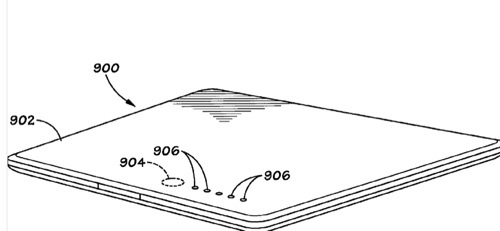Future Apple laptops could sports touch sensitive controls on their covers/lids, per a new patent (number 20110043227) for a method and apparatus for capacitive sensing at the US Patent & Trademark Office.
The disclosure addresses methods and apparatus facilitating capacitive sensing using a conductive surface, and facilitating the sensing of proximity to the conductive surface. The sensed proximity will often be that of a user, but can be another source of a reference voltage potential. In some examples, the described systems are capable of sensing capacitance (including parasitic capacitance) in a circuit that includes the outer conductive surface, and where that outer conductive surface is at a floating electrical potential.
In some systems, the systems can be switched between two operating modes, a first mode in which the system will sense proximity to the conductive surface, and a second mode in which the system will use a capacitance measurement to sense contact with the conductive surface. The inventors are Aleksandar Pance, Omar S. Leung and David Thomas Amm.
Here’s Apple’s summary of the invention: “The present invention relates generally to methods and apparatus for capacitive sensing; and more particularly includes methods and apparatus which use a conductive surface, such as metal, in the sensing mechanism, and which are used to detect proximity and potentially touch of a user in order to provide user input signals to an electronic device.
“Many user interfaces are known which utilize capacitive sensing to identify user inputs to an electronic device, such as a computer, media playing device, phone etc. Some of these interfaces are implemented as touch screen systems where one or more capacitance sensing mechanisms, such as electrodes are placed under a transparent outer surface, typically formed of glass or plastic, and above a display element.
“A limitation of many conventional capacitive sensing devices is that the outer surface needs to be formed of a non-conductive material, such as the glass outer surface of touch screen devices. Thus, even input devices that do not require transparency for operation, such as track pads that operate based upon capacitive sensing, will include a contact surface formed of glass or of another non-conductive material.
“Thus, conventional capacitive sensing input devices for electronic devices offer some limitations on how they may be utilized. For example, applications may be envisioned where it would be desirable to allow for proximity or touch-responsive inputs even where the surface is formed of a conductor, such as a metal. Applications may be envisioned wherein some portion of the outer case of an electronic device, such as a media player or laptop computer, might be sensitive to proximity and/or touch of a user in order to initiate various functions of the device, potentially before there has been any direct contact with the device.
“Accordingly, the methods and apparatus disclosed herein identify systems for sensing the proximity, and in some embodiments, also touch, of a user even where the surface proximate the user is formed of metal or another conductor.”
— Dennis Sellers


